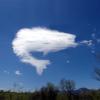I hate it when I damage the fish I catch, which can be a common thing with soft plastic baits. Also, I get to do a lot of sight fishing in the clear shallow ponds I fish, so I'd ended up with a problem at the other end of the spectrum missing fish. What I suspected was happening, and my response to it, has been born out from research on bass feeding behavior. Bear with me; It's interesting, and practical:
Bass mouths are adapted to suction feeding. Suction feeding is a two-part action: Water, with the food, is sucked into the mouth, THEN the water has to be expelled out through the gills. This is important in people missing strikes I believe. I know it has been for me.
The trick is, you have to wait for the bass to expel the water before you set up. This can be less a problem with fish you don't see take because by the time you've detected, the deed is done especially with larger fish. But on a short line, when detection is instantaneous, and on sighted takes, this becomes a key issue.
There's a third part too called handling time how long it takes for the bass to get control of the prey before they ingest it, or spit it out. Handling may involve further suction (gobbling) and crushing bites (with tongue against pharyngeal teeth). Handling time is important for anglers when we use a long lure like a plastic worm and is dependant on the size, and aggression, of the bass. I've noticed that with a 5 Senko (a bulky worm), a roughly 15 bass often takes a couple gobbles to suck down such a worm, which you feel as multiple taps. With really small fish you may feel rapid multiple taps as the small fish attempts to gobble up the length of the worm. I often gently pull the bait away from such fish. With large bass handling time is minimal. Line watchers will see the suction events as a flicks' in the line. On the dead weight' feeling, the fish has already engulfed it. When the line skating off, the deed is done and he's moving off with the bait.
Usually the complete action, with a say 15 bass, is like this: Suck, getting half the worm in, then suck once more to engulf it, then expel the water, then bite down. If I set up anytime prior to the water being expelled, I'll likely pull the bait from them. I have to wait until the bait is in, and then allow them the added second to expel the water. They then bite down on the bait, which is the optimum time to set the hook. Again, the biggest problem, for me and I assume others, has been when sight fishing (seeing the bass take), or on a short line when detection is instantaneous. You have to wait until they go through the process: inhale, and expel the water. This takes a good full second, or two. If I don't see the take and it's a ways out I may miss the sequence and simply feel weight, or see the line moving.
Deep hooking appears to be part of the game with soft plastics. Often, if the bass don't feel you or the weight of the line, they choose to ingest. I don't know any sure way around it. Sometimes you don't detect in time. Sometimes it's a very aggressive hungry fish that ingests right away. Sometimes it's a big one that needs no handling time you can't always tell whether it's a 14 incher or a 20 incher. Salted and formulaic (PowerBait) baits are more apt to be ingested, in my experience and others. (See this particularly interesting post: http://www.bassresource.com/fish_biology/skinny-fish.html) Some waters in Colorado even have a ban on salted lures like Senko's.
I feel somewhat responsible to be careful in fishing with soft plastics, especially the new salted and formulaic baits, (which we can't seem to get away from). I went barbless with my soft plastic baits last year. Studies have indicated that barbless hooks do not always save fish that are deeply hooked (see discussion at: http://www.bigindianabass.typepad.com/big_indiana_bass/2007/10/ But I counter that barbless hooks decrease time spent trying to extract any hook, especially important with gill or esophagus hooked fish.
Anyway, glad you're interested in the issue, as I know we share water here in Colorado. That simply gorgeous 5lber you took last week deserves to swim again. You'll see her later, I'm sure.











